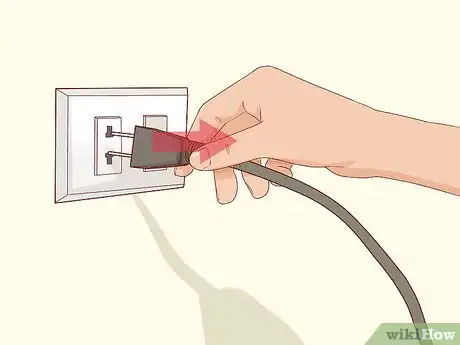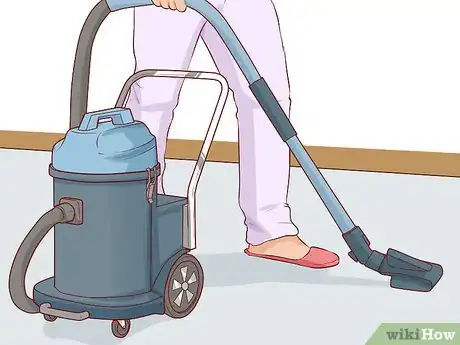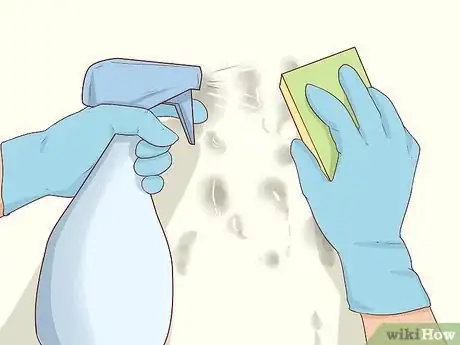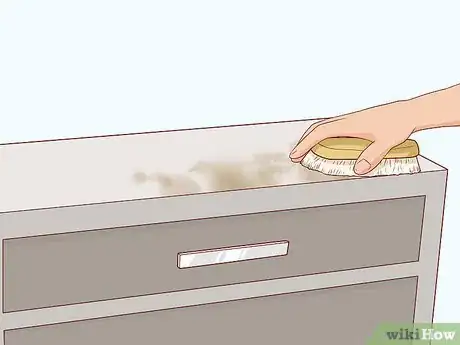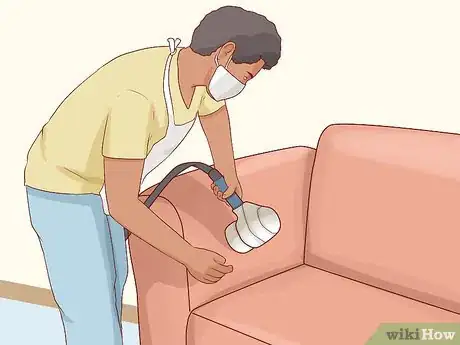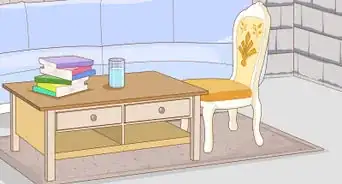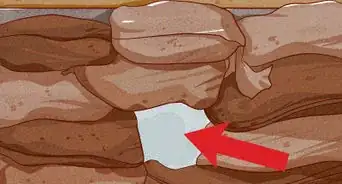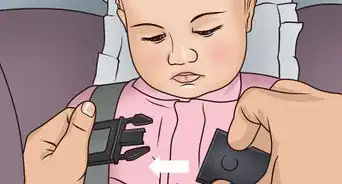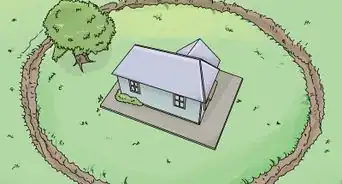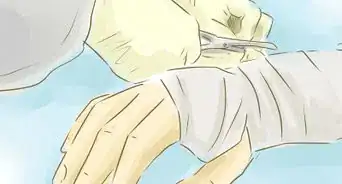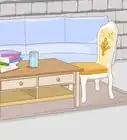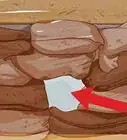This article was co-authored by Ryan Owsiany. Ryan Owsiany is a Drywall and Painting Specialist and the Owner of Patch and Paint Pros in Conshohocken, Pennsylvania. With over two decades of experience, Ryan specializes in interior and exterior house painting as well as drywall, plaster, and water damage repair. Ryan holds a BS in Industrial Engineering from Penn State University. Patch and Paint Pros only employ experienced, friendly painters that understand proper preparation is required to ensure client satisfaction on every painting project.
This article has been viewed 34,556 times.
Water damage can be very frustrating for homeowners. Floods and leaks can cause furniture, appliances, walls, and carpeting to become water damaged. To clean water damage, soak up as much water as possible and then clean and disinfect walls, floors, and furniture. Certain items, like rare or valuable items, should be cleaned by a professional.
Steps
Cleaning Walls and Floors
-
1Unplug everything first. Before you begin cleaning, unplug everything. It is very dangerous to enter a water damaged home if electronics are plugged in. Carefully unplug everything from the wall and turn off any appliances before you begin cleaning.
-
2Soak up as much water as possible with a wet/dry vacuum. If you don't have a wet/dry vacuum, you can rent one at a hardware store. To begin the process of drying out the floor and walls, run the vacuum over your floors, walls, and anywhere else where you notice built up water damage. Sop up as much set in water as possible with the wet/dry vacuum.[1] [2]Advertisement
-
3Steam clean the carpet. For water damaged carpet, your best option is steam cleaning. You can rent a steam cleaner at a local hardware store if you do not own one. Run the steam cleaner over the water damaged carpet to remove moisture and clean your carpeting.[3]
- For very water damaged carpet, professional steam cleaning may be the best option.
-
4Disinfect everything. Water damage can cause the build up of bacteria in your walls, floors, and carpeting. Disinfecting these areas to remove water damage is important. You can buy a disinfectant cleaner at a local grocery store or hardware store. If possible, ask a worker for a disinfectant specifically designed to treat water damage. Scrub down your walls and floors with a disinfectant.
- Read the directions of the disinfectant you purchase. Different disinfectants will need to be diluted with different levels of water.
- You can also make a solution at home using a combination of bleach and water. It depends on the type of bleach you're using, but half a cup of bleach per gallon of water is usually a safe ratio.[4]
-
5Apply a product to prevent mold growth. Mold growth can occur, especially in wood, after water damage. After cleaning and disinfecting your floors and walls, apply a product that inhibits mold growth. Purchase your product at a hardware store or department store. Apply it according to package directions.[5]
-
6Use fans and a humidifier. Even after sopping up most of the water, there is likely some lingering water in your floors and carpeting. Keep fans in the room and have them on for 24 hours a day. This can speed up the drying process. You should also place a dehumidifier in the room if you have one.[6] [7]
- If you don't have a dehumidifier, consider renting one, purchasing one, or borrowing one from a friend. They can really speed up the drying process. The same goes for industrial air movers opposed to regular fans.
Cleaning Furniture and Household Supplies
-
1Remove soaked items immediately. Any furniture that has been soaked in water should be immediately removed from a room. Furniture is likely to get more wet sitting in a water damaged room. Move furniture to a dry area with good ventilation, such as the attic, until you're ready to clean it.
-
2Brush mold and mildew off furniture. In the events of things like floods and leaks, mold, mildew, and debris can build up on furniture. In the event you notice these issues, use a cleaning brush to surface clean your furniture. Brush off any obvious mold and mildew.[8]
-
3Soak up extra moisture using desiccants. Desiccants are materials that absorb moisture. They include things like clay, calcium oxide, and silica gel. After brushing off any obvious mold and debris, sprinkle a desiccant over your furniture. These will help soak up water that's stuck in the fabric.[9]
- It can take anywhere from a few days to a few weeks to soak up the excess water.
- You may need to periodically replace your desiccants if your furniture is very wet. Desiccants change color when they become saturated.
-
4Hand clean appliances. Appliances also get wet and dirty from water damage. You can surface clean appliances with an all-purpose cleaner to rub away any debris built up on their surfaces. However, do not attempt to clean electronics like televisions and stereos on your own. This can cause serious damage. Electronics should be cleaned by a professional.[10]
-
5Throw out mattresses. Unfortunately, mattresses cannot usually be salvaged after water damage. If a mattress gets wet, it's best to dispose of it at a local dump.[11]
Contacting Professionals for Assistance
-
1Make a photographic record of the damage. You should always take pictures of damage after a flood or other natural disaster causes water damage. Photograph each room thoroughly, as well as any appliances that were damaged. This will be important to show to the insurance company when making a claim.
-
2Talk to your insurance company. Call your insurance company after water damage occurs. Explain the extent of the damage to them, and show them evidence like photographs you took. Most homeowners insurance policies should pay for at least some of the costs of cleaning and repair.
-
3Consult professionals to clean valuables. Things like books, photographs, and paintings usually require professional cleaning. Rare or valuable objects especially should only be treated by professionals to prevent damage. Contact professional cleaners in your area that specialize in water damage to clean such objects.
- If there is built up dirt on the objects, cleaners may advice you to rinse them with water before bringing them in to prevent stains from becoming set.
-
4Have upholstered furniture professionally cleaned. Upholstered furniture is difficult to clean on your own in the event of water damage. Hire professional furniture cleaners to deal with upholstered furniture that has been soaked in water.[12]
Expert Q&A
-
QuestionWhat's the first thing you should do if you see water damage?
 Ryan OwsianyRyan Owsiany is a Drywall and Painting Specialist and the Owner of Patch and Paint Pros in Conshohocken, Pennsylvania. With over two decades of experience, Ryan specializes in interior and exterior house painting as well as drywall, plaster, and water damage repair. Ryan holds a BS in Industrial Engineering from Penn State University. Patch and Paint Pros only employ experienced, friendly painters that understand proper preparation is required to ensure client satisfaction on every painting project.
Ryan OwsianyRyan Owsiany is a Drywall and Painting Specialist and the Owner of Patch and Paint Pros in Conshohocken, Pennsylvania. With over two decades of experience, Ryan specializes in interior and exterior house painting as well as drywall, plaster, and water damage repair. Ryan holds a BS in Industrial Engineering from Penn State University. Patch and Paint Pros only employ experienced, friendly painters that understand proper preparation is required to ensure client satisfaction on every painting project.
Drywall & Painting Specialist If you notice a water stain on your ceiling or wall, use a pencil to outline the outside edge of the stain. If the stain gets bigger after a few days—or after the next big rain—then you'll know you have an active leak.
If you notice a water stain on your ceiling or wall, use a pencil to outline the outside edge of the stain. If the stain gets bigger after a few days—or after the next big rain—then you'll know you have an active leak. -
QuestionHow do you stop water damage from getting worse?
 Ryan OwsianyRyan Owsiany is a Drywall and Painting Specialist and the Owner of Patch and Paint Pros in Conshohocken, Pennsylvania. With over two decades of experience, Ryan specializes in interior and exterior house painting as well as drywall, plaster, and water damage repair. Ryan holds a BS in Industrial Engineering from Penn State University. Patch and Paint Pros only employ experienced, friendly painters that understand proper preparation is required to ensure client satisfaction on every painting project.
Ryan OwsianyRyan Owsiany is a Drywall and Painting Specialist and the Owner of Patch and Paint Pros in Conshohocken, Pennsylvania. With over two decades of experience, Ryan specializes in interior and exterior house painting as well as drywall, plaster, and water damage repair. Ryan holds a BS in Industrial Engineering from Penn State University. Patch and Paint Pros only employ experienced, friendly painters that understand proper preparation is required to ensure client satisfaction on every painting project.
Drywall & Painting Specialist If you have an active leak, use a screwdriver or another pointed object to poke a hole where the water seems to be coming from. Then, use a bucket to catch the water. That way, the water can drain out instead of getting sucked up by your drywall.
If you have an active leak, use a screwdriver or another pointed object to poke a hole where the water seems to be coming from. Then, use a bucket to catch the water. That way, the water can drain out instead of getting sucked up by your drywall.
References
- ↑ Ryan Owsiany. Drywall & Painting Specialist. Expert Interview. 20 May 2021.
- ↑ https://www.angieslist.com/articles/6-steps-prevent-carpet-mold-after-water-damage.htm
- ↑ https://www.angieslist.com/articles/6-steps-prevent-carpet-mold-after-water-damage.htm
- ↑ https://www.clorox.com/dr-laundry/making-sure-you-dilute-bleach/
- ↑ http://www.concrobium.com/blog/2012/11/07/tips-for-cleaning-your-home-after-water-damage/
- ↑ Ryan Owsiany. Drywall & Painting Specialist. Expert Interview. 20 May 2021.
- ↑ https://www.angieslist.com/articles/6-steps-prevent-carpet-mold-after-water-damage.htm
- ↑ http://www.floodsafety.com/national/property/cleanup/
- ↑ https://www.houselogic.com/finances-taxes/home-insurance/water-damage-home-repair/
About This Article
To clean up water damage, begin by using a wet/dry vacuum to suction up as much excess water as possible. Then, steam clean any carpet that got wet to get rid of moisture and remove bacteria. Next, make a diluted bleach solution and use it to scrub down your walls and floors to sterilize them. Finally, run fans or a dehumidifier to speed up the drying process so that mold doesn’t have a chance to grow. For tips on how to clean up water damage on household items, like furniture and mattresses, read on!
